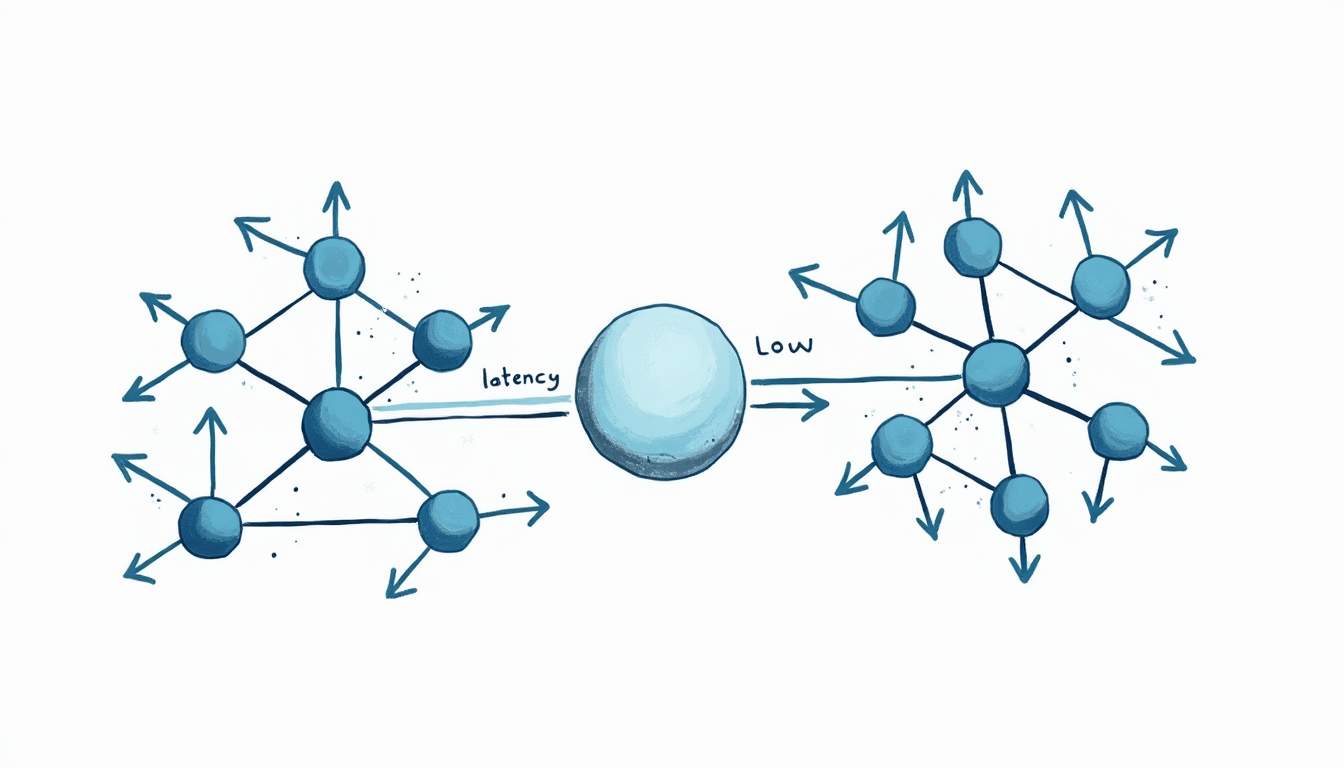Understanding Throughput vs Latency in RPC Performance
In the rapidly evolving world of blockchain and Web3 applications, Remote Procedure Call (RPC) performance stands as a critical factor influencing user experience, scalability, and overall system reliability. Among the key metrics that developers and infrastructure architects focus on are throughput and latency. Understanding the nuances between these two performance indicators is essential for building robust, efficient, and cost-effective blockchain applications.
What Are Throughput and Latency in RPC?
Defining Throughput
Throughput refers to the amount of data or number of requests that an RPC system can process within a given time frame, typically measured in requests per second (RPS). In blockchain infrastructure, high throughput means the system can handle a large volume of API calls, transactions, or queries without bottlenecks.
For example, a blockchain node or RPC provider capable of processing 10,000 requests per second demonstrates high throughput, enabling decentralized applications (dApps) to scale effectively as user demand grows.
Understanding Latency
Latency, on the other hand, measures the time it takes for a single RPC request to be processed and a response to be returned. This is usually expressed in milliseconds (ms). Low latency is critical for ensuring fast user interactions, real-time updates, and smooth application performance.
Consider a decentralized exchange where users expect near-instant trade confirmations. High latency in RPC calls could lead to delays, causing frustration and potential financial losses.
Why Both Matter
While throughput and latency are related, they represent different aspects of RPC performance. A system might have high throughput but suffer from high latency, meaning it can handle many requests but each request takes longer to complete. Conversely, low latency with low throughput means fast responses but limited capacity to handle concurrent requests.
Optimizing for both metrics is crucial, especially in blockchain environments where reliability and speed directly impact user trust and application success.
Throughput and Latency in the Context of Blockchain RPC
The Unique Challenges of Blockchain RPC
Blockchain applications rely heavily on RPC providers to interact with decentralized networks. These providers serve as gateways, processing API calls that query blockchain data or submit transactions. However, blockchain RPC infrastructure faces unique challenges:
- Network congestion: High transaction volumes can overwhelm RPC endpoints.
- Geographical distribution: Users worldwide require access, making latency reduction complex.
- Redundancy and failover: Ensuring uptime during outages demands sophisticated routing strategies.
These factors make throughput and latency optimization a balancing act that requires advanced infrastructure solutions.
Impact of Latency on User Experience
Latency directly affects how responsive a blockchain application feels. For instance, in NFT marketplaces or DeFi platforms, users expect immediate feedback when interacting with smart contracts. High latency can cause delays in transaction confirmations or data retrieval, leading to poor user experience and decreased trust.
Reducing latency often involves deploying multi-region RPC endpoints and leveraging multi-cloud proxies (MCP) to route requests to the nearest or fastest available node. This approach minimizes round-trip times and enhances responsiveness.
Throughput’s Role in Scalability
Throughput determines how well an RPC infrastructure can handle growing user bases and increasing API call volumes. As blockchain applications scale, the demand for RPC requests can reach millions per second. Without sufficient throughput, systems risk becoming bottlenecked, resulting in dropped requests or increased latency.
Multi-provider RPC routing and aggregation solutions play a vital role here. By distributing requests across multiple providers, applications can achieve higher throughput while maintaining redundancy and reliability.
Strategies to Optimize Throughput and Latency in RPC
RPC Auto-Routing and Multi-Provider Solutions
One of the most effective ways to balance throughput and latency is through RPC auto-routing. This technique dynamically directs RPC requests to the best-performing providers based on current load, latency, and availability.
Multi-provider RPC routing not only increases throughput by leveraging multiple backends but also reduces latency by selecting providers geographically closer to the user or less congested at the moment. This redundancy also mitigates the risk of downtime, a critical consideration given the high costs associated with RPC outages in Web3 projects.
Leveraging Multi-Cloud Proxy (MCP) Infrastructure
Multi-Cloud Proxy (MCP) technology is becoming a new standard for blockchain RPC routing. By integrating multiple cloud providers and regions, MCP enables seamless failover and load balancing, improving both throughput and latency.
For example, Google MCP offers blockchain-specific multi-cloud proxy capabilities that help scale APIs efficiently while reducing latency through multi-region routing. This approach ensures that RPC requests are handled optimally, regardless of where users are located.
API Aggregation and Orchestration
Beyond routing, API aggregation and orchestration techniques consolidate multiple RPC endpoints into a single, unified interface. This simplifies development and can optimize performance by intelligently managing request distribution and caching.
API orchestration goes a step further by coordinating complex workflows across multiple services, which can enhance throughput by parallelizing requests and reduce latency by prioritizing critical calls.
Measuring and Monitoring RPC Performance
Key Metrics to Track
To effectively optimize throughput and latency, continuous monitoring is essential. Key metrics include:
- Request rate (RPS): Measures throughput.
- Average and percentile latency: Tracks response times.
- Error rates: Identifies failed or timed-out requests.
- Provider health and uptime: Ensures reliability.
Tools that provide real-time analytics and alerting can help developers detect performance degradation early and adjust routing policies accordingly.
Case Study: Reducing RPC Downtime with Auto-Routing
Consider a Web3 application that suffered frequent RPC outages due to reliance on a single provider. By implementing multi-provider auto-routing, the application reduced downtime significantly, maintaining high throughput even during peak loads and lowering average latency by routing requests to the fastest available nodes.
This example underscores the importance of combining throughput and latency optimization with redundancy strategies to enhance overall RPC performance.
The Economic Impact of Throughput and Latency Optimization
Cost Considerations
Optimizing throughput and latency is not just about performance—it also affects operational costs. High latency can lead to increased user churn and lost revenue, while insufficient throughput may require costly infrastructure scaling.
Multi-provider routing can reduce costs by avoiding over-reliance on expensive single providers and enabling cost-effective load distribution. Additionally, reducing RPC downtime prevents financial losses associated with failed transactions or degraded user experience.
Balancing Performance and Budget
Startups and growing blockchain projects must carefully balance throughput and latency improvements with budget constraints. Implementing auto-routing and multi-cloud solutions can provide significant cost savings—sometimes up to 40%—by optimizing resource utilization and minimizing waste.
Choosing the right RPC providers and leveraging aggregation platforms that support multi-region and multi-cloud deployments are key strategies for achieving this balance.
Conclusion: Why Understanding Throughput vs Latency Matters
In blockchain RPC infrastructure, throughput and latency are foundational metrics that influence application scalability, user experience, and cost efficiency. While throughput ensures the system can handle large volumes of requests, latency guarantees those requests are processed swiftly and responsively.
Modern solutions like RPC auto-routing, multi-provider aggregation, and multi-cloud proxies are transforming how Web3 applications manage these performance dimensions. By adopting these strategies, developers can build resilient, high-performing blockchain applications that meet the demands of an increasingly decentralized and global user base.
Ultimately, a deep understanding of throughput versus latency—and how to optimize both—is essential for anyone involved in blockchain infrastructure, from developers to infrastructure architects and project managers.
Ready to elevate your blockchain project's performance? With Uniblock, you can harness the power of a Web3 infrastructure orchestration platform designed to streamline your development process. Our platform offers a single API endpoint that intelligently auto-routes traffic across multiple providers, ensuring maximum uptime, minimal latency, and cost savings. Join the ranks of over 2,000 developers across 100+ chains who trust Uniblock to eliminate vendor lock-in and empower their growth. Start building with Uniblock today and experience the ease of managing decentralized infrastructure without the manual hassle.
.svg)






